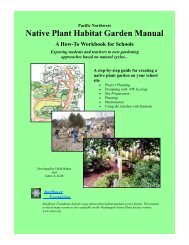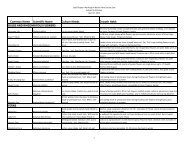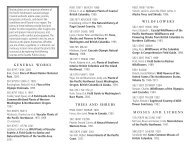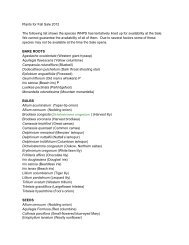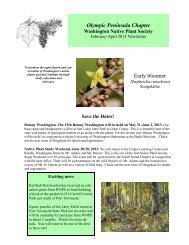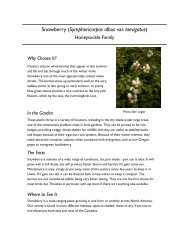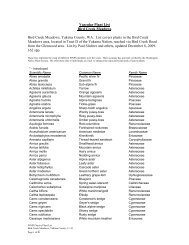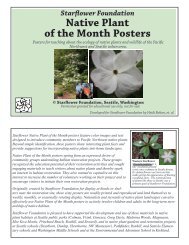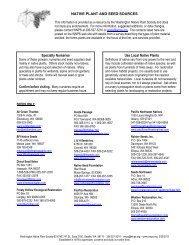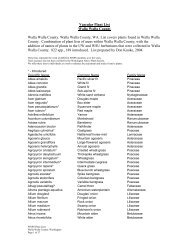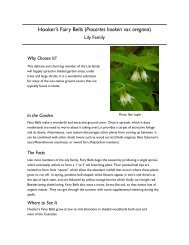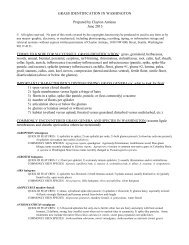Quick & Easy Habitat Education Activities - Washington Native Plant ...
Quick & Easy Habitat Education Activities - Washington Native Plant ...
Quick & Easy Habitat Education Activities - Washington Native Plant ...
Create successful ePaper yourself
Turn your PDF publications into a flip-book with our unique Google optimized e-Paper software.
Foam Core ClipboardsFoam core clipboards are easy to make,affordable, lightweight, water resistant and easy tostore. This style is designed for the 1/2 page worksheetstypical for Q&E activities. Larger foam coreclipboards are more likely to break.Foam core board30”20”Excess material2”6”Cut with a utility knife using a straight- edge as aguide. Each foam core board makes 10 clipboards.Rubber bands can hold paper in place. Clear plasticcan be stapled to one edge to protect paper from rain.9”9”Plastic Baggies and ContainersStore props in plastic baggies, viewingcontainers, storage containers and bins.Kit MaterialsMaterials which can be used repeatedly and stored for future use arelisted. Each activity sheet provides a list of any required ‘Kit Materials’.‘Support Materials Descriptions’ gives details about these materials,along with their suggested sources.Some kit materials such as ‘foam core clipboards’ or jewelerloupe magnifiers are used in several activities. Other kit materialssuch as bagged and labeled natural objects for Nature Detectivesactivity, or seed samples for Seed Dispersal Sort activity may bepreserved for repeat implementation of the same activity. Some kitmaterials such as ‘Game Cards’ in the Maple Seed Mixup activity maybe created from document masters that are printed, cut, laminated andassembled into sets which are best housed in ‘kits’ .‘Kits’ can be made for individual activities, for a series of activities,or for the entire set of Q&E activities. They may be stored inplastic bins or cardboard boxes and clearly labeled for ease of access.Schools may store them in their school library, or in their educationstorage rooms. Stewardship community groups can make and storekits for use while hosting stewardship activities for youth at projects.Making kits provides ideal projects for parent and communityvolunteers, education specialists and parks staff, and the small budgetrequired lends itself to funding by grants, donations and fundraising.Teacher SuppliedSpecified on the “Activity Sheet”, this category indicates suppliesthat are usually readily available in the classroom (such as paper andpencils) or from the habitat area (such as fresh berries or leaves) and thatrequire frequent replenishment. In some cases, further details are providedin the ‘How-to-do Activity’ documents. Parent helpers or classroomassistants can help with gathering and organizing these materials.Using the Outdoors As a ClassroomSchool grounds and nearby parks or natural areas provide an excellent“classroom”. Forethought and a few preparations can makeeducation outdoors an exceptional learning experience. It is best tointroduce students to the natural world during pleasant weather tofoster a favorable initial outdoors experience. Flexibility is one of thegreat advantages to using school grounds or nearby natural areas; youmay conduct impromptu visits on an exceptionally nice day, or delaya planned activity because of inclement weather.Laminating printmaterials ensureslonger use. Laminatedprint materials may behole punched for storagein a binder, and/ormay be bound using fi lerings for fi eld use.Assembling Print Materials in SetsMagnifi ers are useful in manyactivities, and enjoyable forstudents. Jeweler’s loupes aresold affordably as ‘PrivateEyes’ for student use.



